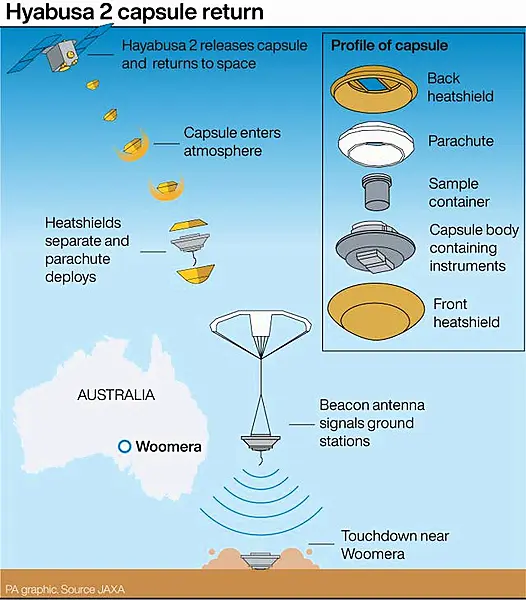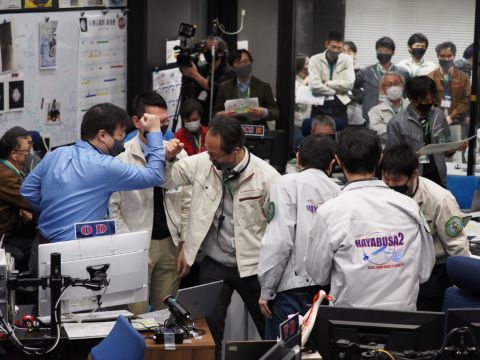A capsule released by Japan’s Hayabusa2 spacecraft has landed in a remote area of southern Australia as planned, officials said, bringing home asteroid samples that could explain the origins of life on Earth.
The Japan Aerospace Exploration Agency (Jaxa) said the Hayabusa2 craft had successfully released the small capsule on Saturday and sent it towards Earth to deliver samples from a distant asteroid, named Ryugu, which could provide clues to the creation of our solar system.

The capsule briefly turned into a fireball as it re-entered the atmosphere 75 miles above Earth. At about six miles above ground, a parachute was scheduled to open to slow its fall, with beacon signals being transmitted to indicate the capsule’s location.
Jaxa official Akitaka Kishi said these signals have now been detected, suggesting the capsule landed safely in a remote, sparsely populated area of Woomera, Australia.
He said Jaxa staff will now carry out an aerial search for the capsule by helicopter.

A retrieval of the pan-shaped capsule, about 15in in diameter, will start after sunrise.
Hayabusa2 left the asteroid Ryugu, which is about 180 million miles away, a year ago. After the craft released the capsule, it moved away from Earth to capture images of the capsule descending towards the planet as it set off on a new expedition to another distant asteroid.
The capsule descended from 136,700 miles away in space after it was separated from Hayabusa2 in a challenging operation that required precision control.
Jaxa staff have begun operations to locate the capsule, which has been described by some commentators as “a treasure box”.

Officials said they hoped to retrieve the capsule by Sunday evening before a preliminary safety inspection at an Australian lab, then bringing it home to Japan early next week.
Dozens of Jaxa staff have been working in Woomera to prepare for the sample’s return.
They have set up satellite dishes at several locations in the target area inside the Australian Air Force test field to receive the signals.
They will use a marine radar, drones and helicopters to assist in the search and retrieval of the capsule.
Australian National University space rock expert Trevor Ireland, who is in Woomera for the arrival of the capsule, said he expected the Ryugu samples to be similar to the meteorite that fell in Australia near Murchison in Victoria state more than 50 years ago.

He said: “The Murchison meteorite opened a window on the origin of organics on Earth because these rocks were found to contain simple amino acids as well as abundant water.
“We will examine whether Ryugu is a potential source of organic matter and water on Earth when the solar system was forming, and whether these still remain intact on the asteroid.”
Scientists say they believe the samples, especially ones taken from under the asteroid’s surface, contain valuable data unaffected by space radiation and other environmental factors.

They are particularly interested in analysing organic materials in the samples.
Jaxa hopes to find clues to how the materials are distributed in the solar system and are related to life on Earth.
Mission managers said said just 0.1 grams of the dust would be enough to carry out all planned research.
For Hayabusa2, it is not the end of the mission it started in 2014. It is now heading to a small asteroid called 1998KY26 on a journey slated to take 10 years – one way – for possible research, including finding ways to prevent meteorites from hitting Earth.
Today (12/6) at 04:31 JST, all operations related to the re-entry of the capsule have ended. The operation was perfect. We will now move into science observation operations, and observe the Earth & moon with scientific instruments.
— HAYABUSA2@JAXA (@haya2e_jaxa) December 5, 2020
So far, its mission has been fully successful. The craft touched down twice on Ryugu despite the asteroid’s extremely rocky surface, and successfully collected data and samples during the 18 months it spent near Ryugu after arriving there in June 2018.
In its first touchdown in February 2019, it collected surface dust samples.
In a more challenging mission in July that year, Hayabusa2 collected underground samples from the asteroid for the first time in space history after landing in a crater that it created earlier by blasting the asteroid’s surface.
Asteroids, which orbit the sun but are much smaller than planets, are among the oldest objects in the solar system and therefore may help explain how Earth evolved.
In Japanese, Ryugu means “Dragon Palace”, the name of a castle at the bottom of the sea in a traditional folk tale.







